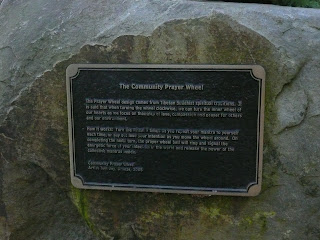I was playing tour guide, driving my first non-family visitor––my prayer partner of 15 plus years––on a scenic tour of my new environs, skirting the edges of the island, headed from one Sound view to the next when we passed a wooden sign on a lonely road, “Hall’s Hill Overlook, In Memory of Noel Burk.” I pulled over and parked. We followed a path from the road into a garden, over a footbridge and a small pond, and happened upon a spectacular cast bronze Tibetan prayer wheel depicting the plants, animals, birds, and marine life here on Bainbridge Island.
Providence––a prayer park presenting itself on this small sojourn, another fitting and precious gift on the spiritual journey my friend and I have walked together since our children were young. Our hands touched the wheel, taking in intricacies as we slowly turned it, read the inscriptions, and were amazed when a chime, deep and resonant filled the crisp air. Then we saw the instructions for this “Community Prayer Wheel” and followed them, lifting up our intentions as we spun the wheel in silence nine times until the bell’s toll released the mantras of the community.
For three years my prayer partner and her family lived in England, back before Skype and Facebook, and our emails were infrequent. I missed her, but I knew she’d come home and we reconnected easily, filling each other in on the details of life we’d missed. We may never live near each other again, so we are learning how to stay in community from afar. Instead of long walks, tea by the fire, and holding hands as we sit side-by-side on a couch, we are praying on the phone, scheduling two or three hour calls, talking with headsets while we sort laundry, wash dishes, pull weeds, then settling down, usually with a cat on our laps, eyes closed, breathing deeply, hearing static in the airwaves as we keep silence, trusting that we haven’t been disconnected, speaking the Lord’s Prayer not quite in unison, so that we can each hear the other.
That beautiful afternoon I twirled the prayer wheel and read its inscriptions while my friend videotaped. “Faith is the daring of the soul to go further than it can see.”
I relish the truth of those words. We are always living out of faith even when we don’t recognize it. As L Frank Baum wrote, “No one knows what’s going to happen next.” I had grown familiar with so much of my life in California that I thought I could see my future clearly. Then, like a snow globe, life shook up and the view was obscured. And in the limited visibility, possibility opened in a way that previous clarity had stifled.
As I become accustomed to life on this island, it’s tempting to think I can see what’s ahead and plan for it––like the bell on the prayer wheel. I’ve taken two other visiting friends to Hall’s Hill Overlook, and each time I was startled by the lovely peal. My spirit leapt as the unleashed prayers vibrated in the chill light reminding me that every day is a daring adventure of faith.









